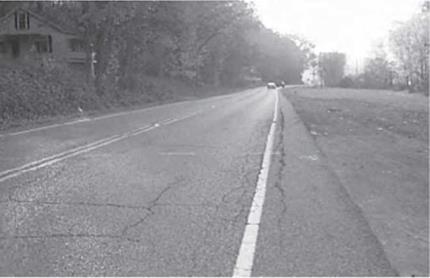Microsurfacing
Microsurfacing is the application of a thin cold-applied paving mixture composed of polymer-modified asphalt emulsion, 100 percent crushed aggregate, mineral filler, water, and other additives. A self-propelled continuous loading machine or a truck-mounted machine is used to proportion and mix the materials and apply the mixture to the pavement surface. Microsurfacing is used to retard raveling and oxidation, fill ruts, reduce the intrusion of water, improve surface friction, and remove minor surface irregularities.
The following conditions should be given careful consideration prior to microsurfacing:
• Localized wheel track cracking or edge cracking (see Figs. 3.57 and 3.58) should be repaired full depth.
• Any potholes must be repaired full depth.
• Areas which exhibit debonding must be patched.
• All existing patches must be in good repair.
• All existing cracks must be sealed.
• Crack sealing is not an acceptable treatment for cracks wider than 1 in (25 mm) as these cracks should be addressed with partial depth repairs.
Microsurfacing is suitable for all traffic levels. However, where ADT is greater than 10,000 vehicles/day, a double application of microsurfacing is required. This requirement is to ensure the wearing surface is durable throughout the intended design life.
|
FIGURE 3.57 Localized wheel track and edge cracking. |
|
FIGURE 3.58 Localized edge cracking. |








Leave a reply